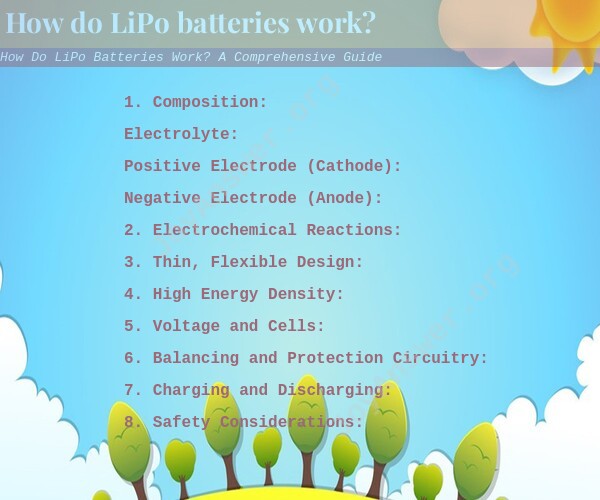How do LiPo batteries work?
LiPo (Lithium-Polymer) batteries are a type of rechargeable battery commonly used in a wide range of applications, from consumer electronics to remote-controlled vehicles and drones. They work based on the principles of lithium-ion chemistry but have some differences in their construction and characteristics. Here's a comprehensive guide on how LiPo batteries work:
1. Composition:
- Electrolyte: LiPo batteries use a lithium-ion electrolyte (a lithium salt dissolved in a solvent). The electrolyte facilitates the movement of lithium ions between the battery's positive and negative electrodes.
- Positive Electrode (Cathode): The cathode is typically made of a lithium cobalt oxide (LiCoO2) or similar material that can store and release lithium ions during charging and discharging.
- Negative Electrode (Anode): The anode is commonly composed of graphite, which can intercalate (absorb) lithium ions when the battery is charged and release them during discharge.
2. Electrochemical Reactions:
- During the charging process (when the battery is connected to a charger), lithium ions are extracted from the cathode and embedded into the anode. This process is known as intercalation.
- When the battery discharges (providing power to a device), lithium ions move from the anode to the cathode through the electrolyte. Simultaneously, electrons flow through an external circuit, creating an electric current.
- The movement of lithium ions and electrons generates electrical energy that can power electronic devices.
3. Thin, Flexible Design:
- One of the distinguishing features of LiPo batteries is their thin, flat, and flexible design. They consist of multiple layers of positive and negative electrodes separated by a porous separator soaked in the electrolyte.
- The flexible pouch or casing allows LiPo batteries to be shaped and sized to fit various devices and applications efficiently.
4. High Energy Density:
- LiPo batteries are known for their high energy density, meaning they can store a significant amount of energy relative to their size and weight. This makes them popular for applications where space and weight are critical factors.
5. Voltage and Cells:
- The voltage of a LiPo battery depends on the number of cells it contains. A single LiPo cell has a nominal voltage of around 3.7 volts, and multiple cells are connected in series to achieve higher voltages. Common LiPo configurations include 1S (single cell), 2S, 3S, 4S, and 6S, each with a different voltage level.
6. Balancing and Protection Circuitry:
- Many LiPo batteries include built-in protection circuitry to prevent overcharging, over-discharging, and excessive current draw, which can be damaging or dangerous.
- Balancing circuitry ensures that the voltage of each cell in a multi-cell LiPo battery remains roughly equal during charging and discharging, preventing cell imbalances that can reduce performance or lead to safety issues.
7. Charging and Discharging:
- LiPo batteries require specialized chargers designed to balance and charge them safely. Incorrect charging can lead to overheating, swelling, or even fire.
- Discharging a LiPo battery below a certain voltage threshold can damage it and reduce its lifespan. Many devices have built-in low-voltage protection to prevent over-discharging.
8. Safety Considerations:
- Handling and charging LiPo batteries require caution due to their sensitivity to overcharging, over-discharging, and physical damage. Always follow safety guidelines and manufacturer recommendations.
In summary, LiPo batteries work by harnessing the electrochemical reactions between lithium ions in the electrolyte and the cathode/anode materials to store and release electrical energy. Their thin, flexible design and high energy density make them ideal for a wide range of applications, but they require proper care and handling to ensure safety and longevity.












